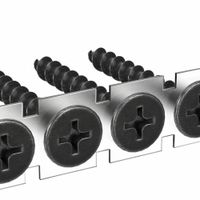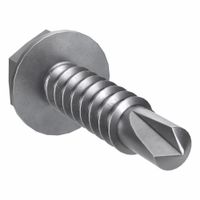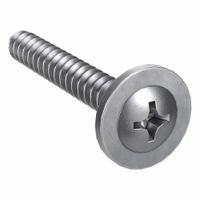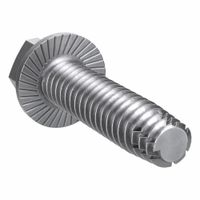Call +(254) 703 030 000 / 751 483 999 / 721 704 777
- Home
- Fasteners
- Bolts Screws
- Drilling Tapping Screws
.....Read More
Frequently Asked Questions
What is the difference between self-drilling and self-tapping screws?
Self-drilling screws and self-tapping screws are both designed to create their own holes as they are driven into materials, but they serve slightly different purposes and have distinct features.
Self-drilling screws, often referred to as Tek screws, have a drill bit-like tip that allows them to drill their own pilot hole in materials such as metal or wood. This eliminates the need for a pre-drilled hole, making them ideal for applications where speed and efficiency are important. They are commonly used in metal-to-metal or metal-to-wood applications, such as in roofing or metal framing. The drill tip is designed to cut through the material, and the threads follow to secure the screw in place.
Self-tapping screws, on the other hand, require a pre-drilled pilot hole. They have a sharp cutting edge on the threads that allows them to tap or cut threads into the material as they are driven in. These screws are used in materials like wood, plastic, or thin metal. There are two main types of self-tapping screws: thread-forming and thread-cutting. Thread-forming screws displace material to create threads, while thread-cutting screws remove material to form threads.
In summary, the primary difference lies in the tip design and application: self-drilling screws have a built-in drill bit for creating their own pilot holes, while self-tapping screws require a pre-drilled hole and are designed to cut or form threads in the material.
How do you choose the right screw for a specific material?
To choose the right screw for a specific material, consider the following factors:
1. **Material Type**: Identify the material you are working with—wood, metal, plastic, or masonry. Each requires different screw types.
2. **Screw Material**: Match the screw material to the application environment. Use stainless steel or brass for corrosion resistance in outdoor or wet conditions. For general indoor use, carbon steel screws are sufficient.
3. **Screw Type**:
- **Wood Screws**: Feature a tapered body and coarse threads for gripping wood fibers.
- **Sheet Metal Screws**: Have sharp threads for cutting into metal.
- **Machine Screws**: Used with nuts or tapped holes in metal.
- **Concrete Screws**: Designed for masonry, with hardened steel and special threads.
4. **Screw Length**: Ensure the screw is long enough to penetrate the material and provide adequate holding power without protruding excessively.
5. **Screw Diameter**: Choose a diameter that provides strength without splitting the material. Thicker screws offer more strength but require larger pilot holes.
6. **Thread Type**: Coarse threads are better for soft materials like wood, while fine threads are suitable for hard materials like metal.
7. **Head Type**:
- **Flat Head**: Sits flush with the surface, ideal for countersinking.
- **Pan Head**: Sits above the surface, providing a finished look.
- **Hex Head**: Offers high torque and is used in heavy-duty applications.
8. **Drive Type**: Select a drive type (Phillips, slotted, Torx, etc.) that matches your tools and provides the necessary torque.
9. **Load Requirements**: Consider the load the screw will bear. Heavier loads require stronger screws with higher tensile strength.
10. **Pilot Holes**: For hard materials, drill pilot holes to prevent splitting and ensure proper alignment.
By evaluating these factors, you can select the appropriate screw for your specific material and application.
What are the advantages of using drywall screws?
Drywall screws offer several advantages:
1. **Secure Fastening**: Designed specifically for drywall, these screws provide a strong hold, reducing the risk of panels loosening over time.
2. **Ease of Use**: Their sharp points and threads allow for easy penetration into drywall and wood studs, facilitating quick installation.
3. **Durability**: Made from hardened steel, drywall screws are resistant to bending and breaking, ensuring long-lasting performance.
4. **Corrosion Resistance**: Many drywall screws are coated to resist rust and corrosion, making them suitable for various environments, including humid areas.
5. **Variety of Sizes**: Available in different lengths and thread types, they can accommodate various thicknesses of drywall and different substrates.
6. **Cost-Effective**: Generally inexpensive, they offer a budget-friendly option for both small and large projects.
7. **Minimal Damage**: Designed to minimize damage to drywall, they reduce the risk of cracking or crumbling around the screw hole.
8. **Versatility**: While primarily used for drywall, they can also be used for other light-duty applications, such as attaching wood to wood.
9. **Aesthetic Finish**: The bugle head design allows the screw to sit flush with the drywall surface, making it easier to cover with joint compound for a smooth finish.
10. **Reduced Splitting**: The fine threads of drywall screws help prevent splitting of wood studs, ensuring a more secure installation.
11. **Compatibility with Power Tools**: Designed for use with power drills and screw guns, they enhance efficiency and speed in construction projects.
12. **Availability**: Widely available at hardware stores, they are easily accessible for both professionals and DIY enthusiasts.
How do you properly install a wood screw?
To properly install a wood screw, follow these steps:
1. **Select the Right Screw**: Choose a screw that is appropriate for the material and thickness of the wood. Consider the length, diameter, and type of screw head (e.g., flat, round, or pan).
2. **Mark the Spot**: Use a pencil to mark the exact location where the screw will be installed. Ensure it aligns with any pre-existing plans or measurements.
3. **Drill a Pilot Hole**: Use a drill bit slightly smaller than the screw's diameter to drill a pilot hole. This prevents the wood from splitting and makes it easier to drive the screw. The depth of the pilot hole should be slightly less than the length of the screw.
4. **Countersink (if necessary)**: If using flat-head screws, use a countersink bit to create a slight depression around the pilot hole. This allows the screw head to sit flush with or below the wood surface.
5. **Choose the Right Screwdriver or Bit**: Select a screwdriver or drill bit that matches the screw head type (e.g., Phillips, slotted, or Torx) to avoid stripping the screw.
6. **Drive the Screw**: Position the screw in the pilot hole and begin turning it clockwise using a screwdriver or a power drill set to a low speed. Apply steady pressure to ensure the screw goes in straight.
7. **Finish Tightening**: Once the screw is mostly in, switch to a manual screwdriver for the final turns to avoid over-tightening, which can strip the screw or damage the wood.
8. **Check Alignment**: Ensure the screw is flush with the surface or at the desired depth. Adjust if necessary.
By following these steps, you ensure a secure and clean installation of a wood screw.
What are the common applications for hex head lag screws?
Hex head lag screws, also known as lag bolts, are commonly used in various construction and woodworking applications due to their strength and durability. Here are some common applications:
1. **Wood-to-Wood Connections**: Lag screws are frequently used to join heavy pieces of wood, such as in timber framing, log cabin construction, and building wooden decks. Their robust design ensures a secure hold in structural applications.
2. **Wood-to-Metal Connections**: They are also used to attach wood to metal, such as securing wooden beams to metal posts or brackets. This is common in building pergolas, carports, and other structures where wood and metal need to be joined.
3. **Heavy-Duty Fastening**: Lag screws are ideal for heavy-duty fastening tasks, such as mounting large, heavy objects like TV mounts, cabinets, and shelving units to walls. Their ability to penetrate deep into wood or other materials provides a strong anchor.
4. **Outdoor and Marine Applications**: Due to their corrosion-resistant properties when made from stainless steel or galvanized materials, lag screws are used in outdoor and marine environments. They are suitable for building docks, piers, and other structures exposed to the elements.
5. **Retaining Walls and Landscaping**: In landscaping, lag screws are used to secure railroad ties, landscape timbers, and other materials in retaining walls and garden structures. Their strength helps maintain the integrity of these constructions.
6. **Furniture Assembly**: For assembling heavy furniture, lag screws provide the necessary strength to hold large pieces together, ensuring stability and durability over time.
7. **Roofing and Framing**: In roofing and framing, lag screws are used to secure rafters, trusses, and other structural components, providing a reliable connection that can withstand significant loads.
These applications highlight the versatility and reliability of hex head lag screws in various construction and assembly tasks.
How do thread-cutting screws work?
Thread-cutting screws are specialized fasteners designed to create threads in pre-drilled holes in materials such as metal, plastic, or wood. They work by using their sharp, cutting edges to remove material and form a mating thread in the substrate, allowing for secure fastening without the need for pre-tapped holes.
The design of thread-cutting screws includes a tapered point and cutting edges, often in the form of flutes or notches, which help in cutting through the material. As the screw is driven into the hole, the cutting edges remove material, creating a thread that matches the screw's own thread pattern. This process ensures a tight fit and strong hold.
There are different types of thread-cutting screws, each suited for specific applications. Type 1 screws have a single flute and are used for general-purpose applications. Type 23 screws have multiple flutes and are ideal for brittle materials like cast iron. Type 25 screws are designed for plastics and other soft materials, featuring a wider thread spacing to prevent cracking.
The advantages of using thread-cutting screws include reduced installation time, as they eliminate the need for tapping operations, and the ability to create strong, vibration-resistant joints. They are commonly used in applications where disassembly and reassembly are required, as the threads they create allow for repeated use without significant wear.
In summary, thread-cutting screws are efficient fasteners that create their own threads in materials, providing a secure and durable connection. Their design and functionality make them suitable for a wide range of industrial and construction applications.
What is the purpose of collated screws?
The purpose of collated screws is to enhance efficiency and convenience in construction and woodworking projects. Collated screws are pre-arranged in strips or coils, designed for use with automatic screw guns or collated screwdrivers. This setup allows for rapid and continuous driving of screws without the need to manually pick and place each one, significantly speeding up the fastening process.
Key benefits include:
1. **Time Efficiency**: Collated screws reduce the time spent on projects by allowing for quick and consistent screw driving. This is particularly beneficial in large-scale projects where thousands of screws are required.
2. **Labor Savings**: By minimizing manual handling, collated screws reduce the physical strain on workers, leading to less fatigue and potentially fewer injuries. This also allows workers to focus on other tasks, improving overall productivity.
3. **Precision and Consistency**: Automatic screw guns ensure that screws are driven to a consistent depth and angle, enhancing the quality and uniformity of the work. This precision is crucial in applications where structural integrity and aesthetics are important.
4. **Reduced Waste**: Collated screws are less likely to be dropped or lost compared to loose screws, reducing material waste and associated costs.
5. **Versatility**: Available in various sizes and types, collated screws can be used for different materials and applications, including drywall, decking, and metal framing.
Overall, collated screws streamline the fastening process, making them an essential tool in modern construction and manufacturing environments.






